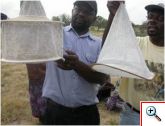 Entomology Program/Vector Biology Unit
Entomology Program/Vector Biology Unit
Overview. The Entomology Program/Vector Biology Unit conducts research on the biology and ecology of vectors of military important diseases with a focus on the development of integrated disease surveillance and management strategies. This department is based on the Kisian campus in western Kenya. Additionally, the Entomology program has six remote field collection sites located in Marigat, Kakamega, Garissa, Wajir, Isiolo, and Lamu. Future field collection sites will be established in Tanzania, Ethiopia, and Uganda. The goals of the Entomology program are to develop products, tools, and methods to mitigate risk and/or prevent vector-borne diseases. Major research efforts include sand fly surveillance for leishmaniasis in the Horn of Africa; sand control methods; dengue; rodent-borne viruses (Hantavirus study); repellent testing; and development of rapid diagnostic tests for infected vectors.
Current Programs.
- Horn of Africa sand fly surveillance. Documentation and risk mapping of vector infection rates for leishmaniasis in Kenya, Ethiopia, Uganda, and Tanzania.
- Rodent borne virus survey. First survey looking for hantavirus reservoirs in East Africa.
- Integrated sand fly control studies. Collaboration with USDA Center of Medical and Veterinary Entomology focused on testing novel combinations of pesticides and novel application techniques for use in the control of adult sand flies.
- Rodent pass through sand fly control studies. Collaboration with Louisiana State University looking at novel control mechanisms for control of larval sand flies. To date, no sand fly larval control method exists.
- Dengue vector surveillance study. Evaluation of several standard surveillance strategies for suitability of use on Kenyan population of dengue vectors.
- Repellants efficacy trials. Comparing novel insect repellent formulations to the military standard, DEET.
- Dipstick assays for leishmaniasis and Rift Valley Fever detection. Evaluation of rapid detection assays for use in the field.
- Treated bed net study. Evaluation of the efficacy of treated bed nets to protect against biting sand flies.
- Mosquito control using provector traps. Use of baited attractant traps to control mosquitoes resting inside dwellings.
- Efficacy of metal solutions for use as mosquito larvicides. Collaboration with the USGS evaluating proprietary metal solutions for use in larval control strategies.
- Malaria vector temperature sensitivity study. Evaluation of the effect of diurnal temperature fluctuations on larval pupation and survival rates.